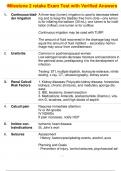Milestone 2 retake Exam Test with Verified Answers
1. Continuous blad- A three-way (lumen) irrigation is used to decrease bleed-
der irrigation ing and to keep the bladder free from clots—one lumen
is for inflating the balloon (30 mL); one lumen is for instil-
lation (inflow); one lumen is for outflow.
Continuous irrigation may be used with TURP.
The amount of fluid recovered in the drainage bag must
equal the amount of fluid instilled -- secondary hemor-
rhage may occur from overdistension
2. Urethritis Common in postmenopausal women
Low estrogen levels decrease moisture and secretions in
the perineal area, predisposing it to the development of
infection
Testing: STI, multiple dipstick, leukocyte esterase, nitrite
testing, x-ray, CT, ultrasonography, kidney scans
3. Renal Calculi 1. Kidney diseases: Polycystic kidney disease, horseshoe
Risk Factors kidneys, chronic strictures, and medullary sponge dis-
ease
2. IBD, ileostomy, bowel resection
3. Medications: Antacids, acetazolamide (Diamox), vita-
min D, laxatives, and high doses of aspirin
4. Calculi pain Requires immediate attention
IV or IM opioids
IV NSAIDs
If pain increases, notify HCP
5. Imitrex con- Ischemic heart disease
traindications St. John's wort
6. Seizures Assessment
· History, factors/precipitating events, alcohol, aura
Planning and Goals
· Prevention of injury, control seizures, psychosocial ad-
, Milestone 2 retake Exam Test with Verified Answers
justment, understanding, absence of complications
Nursing Interventions
· Prevent injury, seizure precautions
Reducing Fear of Seizures
· Adhere to prescribed treatment, take on a regular basis,
monitor for drug resistance
Precipitating factors:
· Emotional disturbances, new environmental stressors,
onset of menstruation, fever, change in lifestyle routine,
bright flickering lights, stress, alcohol
Monitoring and Managing Potential Complications
· Status epilepticus
· Toxicity of meds
7. Hyperthy- Ophthalmopathy - exophthalmos (abnormal protrusion of
roidism one or both eyeballs), (not always reversible)
signs/symptoms
Nervousness: Hyperexcitable, irritable, apprehensive, ·
cannot sit quietly, fine hand tremor
Cardiac: palpitations, rapid pulse, A-fib (new onset in
adults), fatigability, weakness
Skin: tolerate heat poorly, perspire, flushed skin, dry skin,
diffuse pruritus
GI: · amenorrhea, changes in bowel function, increased
appetite, weight loss
8. Exophthal- Assessment:
mos-POC - Vision changes, trauma, visual acuity
Treatments:
- Antibiotic eyedrops if infection is the underlying cause
- Antithyroid therapy (propylthiouracil, methimazole), if
, Milestone 2 retake Exam Test with Verified Answers
Graves' disease is the underlying cause
- Corticosteroids for optic neuropathy
- Eye lubricants (artificial tears)
- Surgery if vision is threatened
General:
- Cold/warm compresses (trauma)
- Eye protection (sunglasses)
Testing:
- CT, MRI, ultrasonography
9. Sensory percep- The heels are particularly susceptible to breakdown be-
tion peripheral cause of loss of sensation of pain and pressure associat-
neuropathy ed with sensory neuropathy.
The skin is assessed for dryness, cracks, breakdown,
and redness, especially at pressure points and on the
lower extremities. The patient is asked about symptoms
of neuropathy, such as tingling and pain or numbness of
the feet. Deep tendon reflexes are assessed.
Teaching: Use a mirror to inspect feet daily.
10. Diabetes foot Feet should be cleaned, dried, lubricated with lotion (but
care not between the toes), and inspected frequently
Supine position - alleviate pressure on the heels by ele-
vating lower legs on a pillow, the heels positioned over the
edge of pillow
Seated in a chair - position feet so that no pressure on
heels
If ulcer on one foot - provide preventive care to the unaf-
fected foot and special care to affected foot.
11. Preop labs pH 7.35 - 7.45
pCO2 35 - 45




